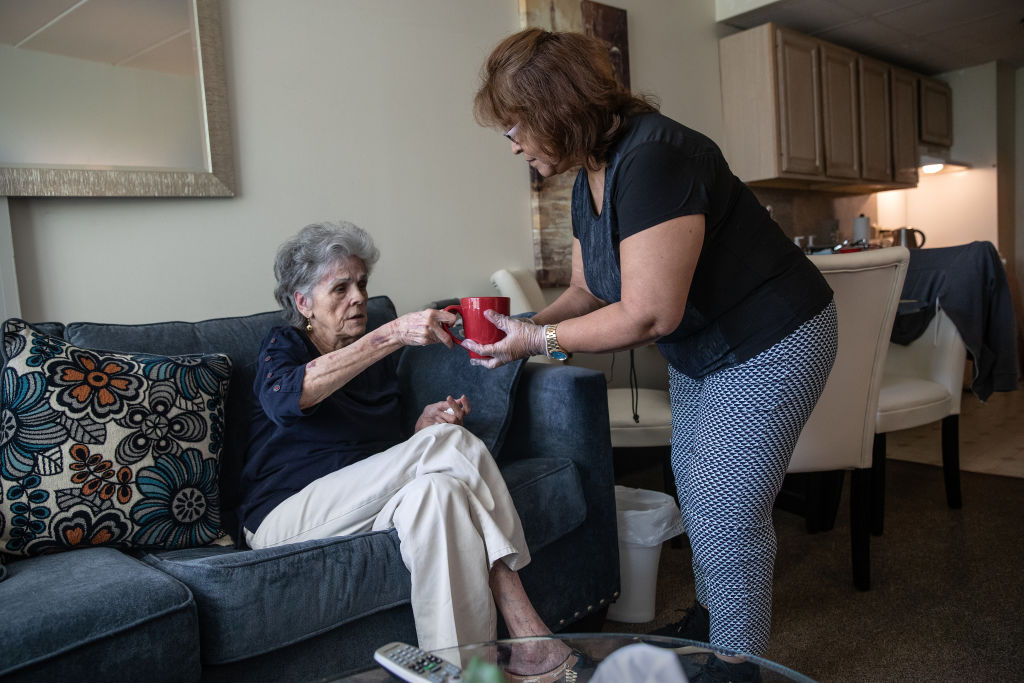Reopening the Golden State
Caregivers See Threats from COVID-19 and Budget Cuts
As California reopens, essential home care workers may have their hours cut.

For workers who provide in-home care for disabled and elderly individuals, reopening the economy is a risky proposition. As a low-paid workforce, they are particularly vulnerable to both exploitation and infection. At the same time, they are a crucial link in the health care system, allowing individuals who are most susceptible to COVID-19 to remain at home instead of in congregate facilities. Since the start of the pandemic, home care workers and their advocates say they have been shouldering the burden of keeping themselves and their consumers healthy with limited resources and little support.
Given the risk of infection that home care workers face even with stay-at-home orders in place, workers are concerned about the prospect of reopening too soon. “I absolutely don’t feel protected, and now that things are opening back up, I can’t stop any of my consumers from having guests at their homes or even going out if they’re able,” says Anjeneau Ward, one of California’s approximately 217,000 home care workers. “That leaves me and my family unprotected.”
The U.S. home care industry, which includes nearly 1.4 million workers, is more than 85 percent female. In California, close to three-quarters of the home care workforce is nonwhite, and 47 percent are immigrants.
As the economy reopens, California’s home care workers are seeking increased investment from the state
– but budget cuts look more likely.
Home care providers help with cooking, cleaning, bathing, administering medicine and other household tasks — which keeps their clients out of state institutions or private elder-care facilities. “[Home care workers] are on the front line in this fight against COVID,” says Kim Evon, executive vice president of the Service Employees International Union (SEIU) 2015, which organizes long-term care workers, including home care workers, skilled nurses and assisted living facility staff. “These workers are the critical link in our health care system that allow the elderly adults and children with disabilities to stay in their homes. It’s an especially critical need as the state continues to face shelter in place orders.”
Home care workers may be employed through state programs such as In Home Supportive Services (IHSS), through agencies or directly by consumers. Regardless of how they are employed, home care workers—like all other domestic workers—fall outside the scope of workplace health and safety regulations. “Domestic workers have been excluded from many of the basic labor protections that other workers have,” says Rocío Avila, state policy director and staff attorney for the National Domestic Workers Alliance. “When they step foot into somebody’s home, that home becomes their workplace.” California law currently exempts private residences from the health and safety standards that govern other workplaces. However, advocates hope that could change soon with Senate Bill-1257, a bill introduced this year by state Sen. Maria Elena Durazo (D-L.A.) that would subject domestic workplaces to inspections and implement rules around health and safety.
* * *
Anjeneau Ward takes care of two clients in the Central Valley city of Stockton through IHSS and has worked in the industry since 2013. Ward starts her day caring for an 83-year-old who has pre-dementia before traveling to the home of her second client, a 52-year-old who is HIV-positive and needs complete care following two major strokes. Every day she visits both clients twice.
IHSS Worker: “I make enough money not to qualify for any government assistance but I don’t make enough money to be able to afford my own medical insurance.”
Both of Ward’s clients are high risks to contract severe cases of COVID-19. “It’s been chaotic, and that’s an understatement,” she says of working through the pandemic. Because it is impossible to maintain physical distance while working, personal protective equipment (PPE) is absolutely necessary to keep Ward and her clients safe. Although she is designated as an essential worker, getting access to PPE has been a continuous struggle. Ward says she did not receive any PPE from the state until several weeks into the lockdown and had to rely on what she could source from picked-over retailers. When she finally did receive PPE, the masks and gloves she was provided were too small to fit her properly. “I can’t do anything with a mask that doesn’t fit my face,” says Ward. “I can’t do anything with gloves that I can’t fit—and they’re still unavailable in the stores for the most part.”
According to Evon, “It wasn’t until week eight that the state acted on getting personal protective equipment [to workers].” Evon says, “That didn’t happen without them acting and making calls and having to push and say, ‘Hey, we’re frontline workers. We are essential and yet we’re still waiting to get this equipment.’”
An April 17 communication from the state announced the distribution of PPE only to IHSS workers taking care of individuals with “suspected or confirmed” cases of COVID-19. It wasn’t until May 19 that the state authorized counties to distribute PPE to any IHSS worker who requested it.
* * *
During the pandemic, home care workers have faced additional stress because they are responsible for monitoring the medical needs of their clients and deciding when it is necessary to risk a trip to the hospital. “Unlike institutional settings like nursing homes or hospitals, where there is medical staff on call, they are the only ones trying to make assessments and decisions,” says Evon. “They are taking on that in a very isolated way with a lack of support.”
Ward is concerned about keeping her clients healthy, but she is also worried about her own safety. “It’s been really exhausting trying to make sure that I am being sanitary enough not to pass the virus to either one of my clients, as well as my son, doing the shopping for three households instead of just one.”
Reopening the economy could be riskier for home care workers due to the close-contact nature of their employment.
According to Evon, those concerns ring true across the industry: “There is just an incredible amount of anxiety [from] balancing the need for them to ensure that their consumers remain healthy and safe, along with themselves and their families. They play the role of often being the point of contact in the community for their consumers.”
Despite the risks and responsibilities of the job, home care workers typically earn low wages. “I am one of the fortunate people who make enough money not to qualify for any government assistance, including medical insurance, but I don’t make enough money to be able to afford my own medical insurance,” says Ward. “I am running the risk every day of becoming infected and then not being able to afford the care that I would need.” Ward is also concerned that if she did become ill, there could be major consequences for her clients as well. “I don’t have assurance that they would be taken care of if I were to come down sick,” she says. A March 30 communication from the state required all of California’s counties to implement back-up plans for when providers get sick.
According to Avila, reopening the economy could be riskier for home care workers than for other sectors. “At this moment the pandemic is not under control. We are reopening with a lot of caution, but it’s … not going to impact every single worker in the same way,” she says. “The nature of the work makes [home care workers] vulnerable as is, so if they are not provided additional support to try to minimize their exposure, they are at an extremely high risk.”
Evon agrees that the unique role of home care workers makes them both especially vulnerable to the virus and especially important in the fight against it. “When you open up these counties, if you’re not factoring in that these very people are the ones that have the one-on-one care with the most vulnerable populations and they don’t have what they need . . . you haven’t really solved the problem around prevention,” she says. Evon believes that for home care workers to be safe as the economy reopens they will need to be prioritized when it comes to adequate PPE, testing and tracing, and overall investment.
But with Gov. Gavin Newsom’s revised 2020-21 budget, cuts to IHSS look more likely. To help balance the state budget, Newsom’s plan would reduce the care hours that IHSS beneficiaries are eligible to receive by seven percent. “It is not the time in this moment to be disinvesting in the care of seniors and people with disabilities or the people who provide that care. This is the time to invest more,” says Evon.
Anjeneau Ward acknowledges that need for investment, too. “When something is essential, it’s cared for and protected because it’s too valuable to lose,” she says. “I don’t feel protected at all.”
Copyright 2020 Capital & Main

-

 Latest NewsDecember 8, 2025
Latest NewsDecember 8, 2025This L.A. Museum Is Standing Up to Trump’s Whitewashing, Vowing to ‘Scrub Nothing’
-

 Striking BackDecember 4, 2025
Striking BackDecember 4, 2025Home Care Workers Are Losing Minimum Wage Protections — and Fighting Back
-

 The SlickDecember 2, 2025
The SlickDecember 2, 2025Utility Asks New Mexico for ‘Zero Emission’ Status for Gas-Fired Power Plant
-

 Dirty MoneyDecember 3, 2025
Dirty MoneyDecember 3, 2025Trump’s Anti-Climate Policies Are Driving Up Insurance Costs for Homeowners, Say Experts
-

 Child FarmworkersDecember 5, 2025
Child FarmworkersDecember 5, 2025To Protect Underage Farmworkers, California Expands Oversight of Field Conditions
-

 Column - State of InequalityDecember 4, 2025
Column - State of InequalityDecember 4, 2025Can California Claw Back Some Medi-Cal Care?
-

 Latest NewsDecember 10, 2025
Latest NewsDecember 10, 2025Capital & Main, L.A. Times Win Sidney Award for Reporting on Child Farmworkers
-

 StrandedDecember 9, 2025
StrandedDecember 9, 2025Giving Up on the Dream: Asylum Seekers Try Other Options in Mexico

